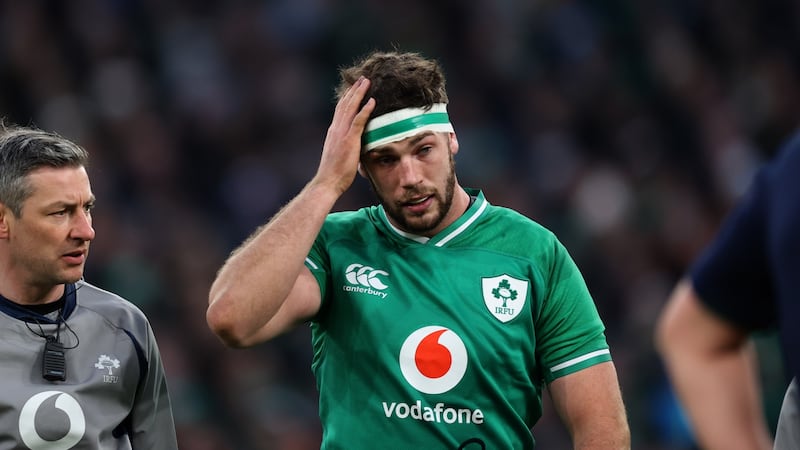There is no escaping the head injuries that continue to malevolently stalk rugby. Professional rugby league players this week downloaded the most recent class action case in the UK, a group of former internationals formally announcing their intention to bring legal action against the Rugby Football League.
Their claim is the governing body failed to protect them from the risks of brain damage caused by concussion. It is the same UK law firm, Rylands Legal, that has been dealing with a similar claim from rugby union players.
On Tuesday one of Leinster and Ireland's emergent talents, backrow Caelan Doris, was able to add personal detail to a complex subject where full understanding continues to evolve. Doris travelled to the UK for specialist attention following a series of concussive blows with club and country. He subsequently experienced problems with cognitive functions and short-term memory loss as well as issues with speech.
“Yeah, it was kind of tough making that decision [to travel to Birmingham],” said Doris, who is included in Andy Farrell’s squad for the upcoming series of matches against Japan, New Zealand and Argentina. Doris plays in the highly competitive backrow as a blindside flanker and number eight. His symptoms were textbook for a concussion injury.
“Some cognitive ones, some around concentration, short-term memory sometimes, a little bit of speech stuff,” he says. “But again, it’s hard to know when you’re getting a few of these knocks and you are sort of hyper aware and hyper vigilant of any deviation from any normal cognitive function.
“So any sort of . . . can’t remember someone’s name or the name of something or forget to do something – you’re attributing it to these knocks, which mightn’t actually be the case. There is probably a bit of worry around it as well.
“My initial cognitive testing was pretty good, a little bit down. Then I did another one a couple of weeks later and it was further up. So it probably was a little bit down from the knock. But it’s back, thankfully. Back to my baseline. Maybe not the normal baseline.”

Doris suffered two bad head injuries, one against Treviso with Leinster in his first European start with the province and another playing for Ireland against Scotland in his first international cap.
Following the two heavy blows, he then suffered two more lighter contacts, one of those against Ulster just before the Six Nations Championship, when the Irish squad was in camp. The match was a training game against an Ulster team.
“That was sort of the key one in making the decision to step back and get fully checked out,” says Doris. “I had been a little bit worried about some symptoms at that stage. So, I got the battery of tests – everything from cognitive to balance to brain scans, bloods everything.
“I’m pretty happy with where I am now. I have always got those baselines to look back to, if there are worries again in the future. I am glad I did it. Definitely a tough decision at the time. But grateful I did and grateful I am able to play again now.”
One change to his protective gear when he is competing is that he now wears a scrum cap, which has traditionally been seen as effective in preventing scratches and cuts and protecting the ears but not protective against concussion.
In Olympic boxing athletes moved from head protectors to not wearing any at the 2016 Olympics following studies that showed head protection did not prevent the concussive blows that cause injury.
They concluded that the head guards created a bigger target for boxers, who in turn attempted more head blows. They also believed the gear was giving athletes a false sense of security.
Studies commissioned by the governing body during World Championship events from 2009 to 2013 found that the number of acute brain injuries declined when head guards were not used and the number of times a fight was stopped because one boxer received repeated head blows fell by 43 per cent in bouts without head guards. The point remains one of contention.
“I think most scrum caps are just seen as protecting from cuts and protecting your ears, whereas this new one is actually a medical device,” says Doris.
“It’s classified as a medical device and has a fair few studies behind it showing that it reduced the force to the head. So I was talking to the company towards the end of last year and then just decided to give it a crack this year.
“There are a fair few things you can do to prevent concussion. Tackle technique is obviously huge, neck strength as well to protect the whiplash effect, time out if you are having a few [head knocks] and then building up that threshold again.
“But I thought having an extra layer of foam around my head will do no harm, so I am going to try it for a while anyway and see how I go. I am happy enough wearing it at the minute.”
The affirmative action is encouraging. But inevitably a concussion watch will ensue with head injuries, if any, counted and examined. Perhaps the reassuring aspect of that is Doris, whose both parents are psychotherapists, has armed himself with the concerned self awareness to cautiously lead that examination.






